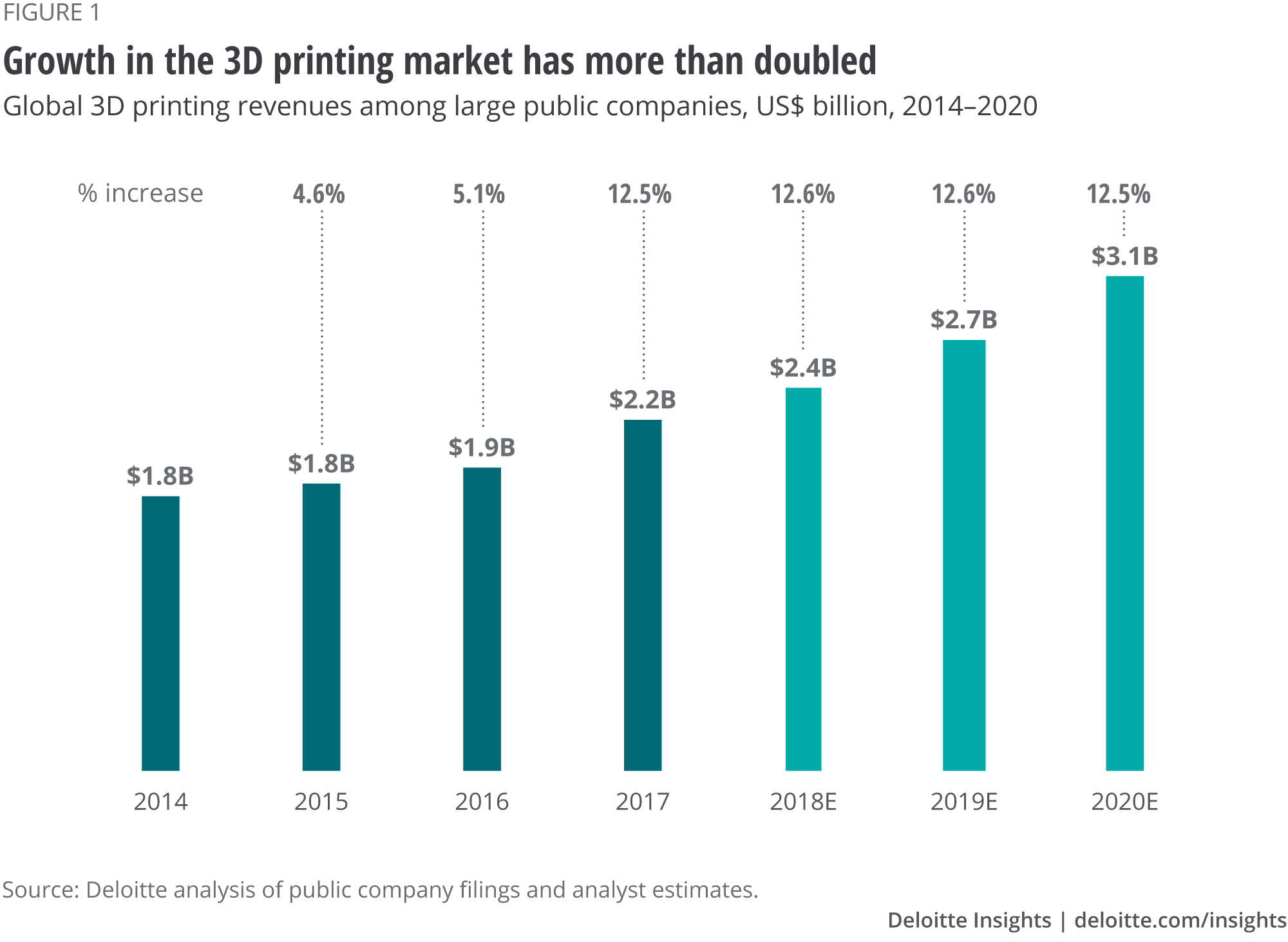
3D printing growth accelerates again TMT Predictions 2019
11 minute read
11 December 2018
With advances in the technology, the 3D printing industry has powered past a slight slowdown to arrive at a steady state of double-digit expected growth.
Deloitte Global predicts that sales related to 3D printing (also known as additive manufacturing) by large public companies—including enterprise 3D printers, materials, and services—will surpass US$2.7 billion in 2019 and top US$3 billion in 2020. (For context, the global manufacturing sector’s revenue as a whole totals roughly US$12 trillion annually.1) This part of the 3D printing industry will grow at about 12.5 percent in each of those years, more than double its growth rate just a few years ago (figure 1).
3D printing is experiencing this inflection point likely because companies across multiple industries are increasingly using it for more than just rapid prototyping. 3D printers today are capable of printing a greater variety of materials (which mainly means more metal printing and less plastic printing, although plastic will likely still predominate); they print objects faster than they used to, and they can print larger objects (build volume). A steady stream of new entrants is expanding the market. 3D printing is considered “an essential ingredient” in Industry 4.0,2 the marriage of advanced production and operations techniques with smart digital technologies that is being heralded as the “Fourth Industrial Revolution.”

Before we examine why the 3D-printing industry is accelerating, it’s worth explaining the methodology behind our market-size estimates. There are other reports that give historical, current, and forecast market sizes for the industry. However, they are based on proprietary research and are hence neither reproducible nor falsifiable. In contrast, due to our focus on large public companies, our historical and current data is culled from publicly available sources with audited financials and updated quarterly. Our forward-looking estimates again draw on publicly available information and are based on consensus analyst estimates where they exist; for some of these companies, more than a dozen analysts provide forward-looking estimates.
The rise, fall, and rise of 3D printing
Learn more
Listen to the related podcast
Watch the video or view the infographic for this prediction
View TMT Predictions 2019, download the full report, or create a custom PDF
Learn how additive manufacturing can transform your organization.
Like many new technologies, 3D printing was overhyped to an extent in its early days. By 2014, the industry (including but not limited to large public companies) posted revenues of more than US$2 billion, up from less than US$1 billion in 2009 (the year when certain fundamental patents expired, and the first consumer home 3D printer—the RepRap3—was introduced as a result). News articles talked excitedly about “the factory in every home,” and there were predictions that traditional parts manufacturers, warehouses, and logistics companies would all be significantly disrupted in the short term. In reality, at that time, 3D printers were largely being used to make plastic prototypes, and although home 3D printers could be fun and educational, the things that they made were almost never of functional value.
Overhyped, the industry slowed, though it did not collapse. As can be seen in Figure 1, the large public companies in the industry experienced mid-single-digit percentage growth in 2015 and 2016 (although some companies did see year-over-year revenue declines), entering a trough of lowered expectations after the excessive hopes of the previous years. However, it was a shallow trough, and by 2017, growth had accelerated again. Today, we predict that annual industry growth will be well above 10 percent for the next few years at least.
Why the rebound in growth prospects? More 3D-printable materials, for one thing. In 2014, the list of materials that could be used in 3D printing was already long, but still far short of the complete list of materials that are commonly used in parts manufacturing. Plus, many parts need to be made of more than one material, a task to which the 3D printers of the time were not well suited. Fast-forward to the beginning of 2019, and the list of possible 3D-printable materials has expanded to more than double what it was five years earlier, and mixed-material printers are becoming more common.
The biggest shift in this regard has often been away from plastic and toward metal printing. Plastic is fine for prototypes and certain final parts, but the trillion-dollar metal-parts fabrication market is the more important market for 3D printers to address. Between 2017 and 2018, a 3D-printing industry survey showed that, although plastic was still the most common material, its share in 3D printing fell from 88 percent to 65 percent in that single year alone, while the share of metal printing rose from 28 percent to 36 percent.4 At that rate, it seems probable that metal will overtake plastics and represent more than half of all 3D printing as soon as 2020 or 2021.
Another factor is speed. Building a part (out of any material) one ultrathin layer at a time is an inherently slow process. But things have changed since 2014. While print time can vary by the complexity of the shape being made, the quality of the print job, and/or the materials being used, the 3D printers on the market in 2019 are twice as fast, broadly speaking, as those that were available in 2014, all else being equal.
One particularly interesting innovation is in the metal-printing arena. In the last few years, many metal parts have been printed using selective laser sintering (SLS). This process is relatively slow and expensive, and it requires a near-vacuum environment. A more recent technology called binder jet metal printing, which could halve the time required to produce each part, is poised to become widely available in 2019.5 (That said, although binder jet technology makes the actual 3D-printing part of the process much faster than SLS, the parts so printed are not yet finished, and require postprocessing by sintering—baking them in an oven until the metal powder fuses. However, while sintering takes time, it can be done en masse, so the average time per part for larger numbers of parts is still faster than SLS.)
Not only are 3D printers getting faster, but their build volume—the printable objects’ size—is growing. A few years ago, a typical high-end metal printer could only build an object that was smaller than 10 x 10 x 10 centimeters, or a cubic liter. In 2019, multiple printers are available with a 30 x 30 x 30-centimeter volume, or 27 cubic liters. This allows for larger objects to be made without needing to print smaller objects and then assemble them. Further, progress is being made on very large build volumes, with the x, y, and z axes measured in meters rather than centimeters, at labs such as Oak Ridge National Laboratory with its Big Area Additive Manufacturing (BAAM) technology.6
Finally, some large companies are entering the 3D-printing market, validating the space and pushing the overall industry to innovate even faster. These large companies bring research investment, credibility, large customer bases, and marketing muscle—and fortunately for the industry’s growth, they are generally expanding the overall pie rather than taking sales away from existing players. The revenue these Fortune 500 companies realize from 3D printing is immaterial for them—for a US$50–100 billion company, even US$250 million in 3D-printing-related revenue would represent less than 0.5 percent of its sales—but it is highly material for the 3D-printing industry and will likely represent about 15 percent of the 3D-printing industry’s total revenue by 2020. Also, the entry into 3D printing by these larger companies is highly strategic for them in a product sense: They are using 3D printing to manage the long tail and improve part performance in interesting ways, such as printing lighter-weight parts, gaining more flexibility in manufacturing, simplifying components, and so on.
Will 3D printing become 100 percent of the manufacturing market?
With all the improvements of recent years, it might be asked why 3D printing is growing at “only” 12 percent or so per year. If 3D printers are now that useful in making final parts, why wouldn’t growth be higher still? And will 3D printing ever become the only way things are made?
In short, no. But to understand why, it’s worth exploring how parts are manufactured in a little more detail.
There are essentially three ways to make a part:
- Take the amount of material needed, and shape it as desired
- Take a block of too much of the material, and remove what is not needed (subtractive manufacturing)
- Build the part up bit by bit over time using the material until the desired part is finished (additive manufacturing or 3D printing)
The first approach can involve multiple techniques and materials; forging, casting, stamping, and molding (injection molding for plastics) are among the most common. These techniques have been used for decades or even centuries; they are well understood, relatively inexpensive on a per-part basis in volume, and produce each part, on average, in a few seconds (not including finishing—in almost all kinds of parts manufacturing, further processing for finishing is required, which can take from seconds to hours). As of 2018, the machines that work this way are worth US$300 billion per year,7 producing parts worth over a trillion dollars annually. As a mature industry, this mode of manufacturing is growing at about 2–3 percent per year, on average, worldwide.
The second technique—subtractive manufacturing—may involve the use of lathes and many other large factory tools, but importantly, it can also be carried out by computer numerical control (CNC) machines, which are becoming near-ubiquitous. Making objects with CNC machines costs more per part than the techniques described above, and it takes minutes per part instead of seconds (excluding finishing time). However, CNC-machine-based manufacturing is very useful in many markets, especially where volumes are lower than would justify making a mold (for example) or where the final part cannot be made using the older techniques. The global CNC-machine market is growing at about 7 percent per year, about twice as fast as traditional manufacturing; it is expected to reach US$100 billion by 2025, up from about US$60 billion in 2018.8
Additive manufacturing—3D printing—is still more expensive per part than using a CNC machine (making it much more expensive than traditional manufacturing), and it takes hours per part instead of minutes (again excluding finishing and postprocessing of various kinds). However, there are parts that can only be made with 3D printing, as well as situations in which part volumes are so low that neither traditional nor subtractive manufacturing is optimal. These are the markets that are driving some of the growth that we predict for 3D printing. An additional growth driver is that 3D printing is often quite useful for making the molds, casts, tools, dies, and jigs that might be used in the first two techniques.
3D printers are not always the right tool for the job, and for the foreseeable future, most parts will still likely be created by casting, forging, stamping, molding, and the like; a small proportion will be made with CNC machines, and an even smaller proportion will be made with 3D printing. But even 1 percent of a multitrillion-dollar global parts industry—the annual metal parts industry alone is worth a trillion dollars9—is still a large opportunity.
Further, the proportions of parts made using each of the three techniques refer to the unit volume of parts. But objects made with CNC machines and 3D printers tend to be of much higher value than those made traditionally, so the dollar value of the parts made by more advanced techniques will be higher than the unit percentages indicate. In other words, parts such as nuts and bolts will be made the traditional way. But those parts are commodities and cost pennies, while 3D-printed parts can be worth hundreds or even thousands of dollars.
The fact that 3D printers will not likely replace traditional manufacturing techniques is important. If manufacturers had to throw out all of their old machines and switch to a completely 3D-printed world, it would be a massive undertaking, but at the end of the process, it would have a certain simplicity. All goods would be made with 3D printers, and although companies would need large stocks of the feed materials, they would no longer need parts warehouses, depots, and distribution centers. The supply chain and logistics problems would be different from those of today, and simpler in some ways.
That likely isn’t going to happen. Instead, companies and industries will always have to deal with a mixed manufacturing world, which is much more complex and difficult to manage. Parts will be made using all three approaches, often more than one of them at a time (which is actually a fairly important technique, expanding the market considerably).10 All of this makes the solutions described below even more important than if 3D printing simply took over.
Bottom line
In today’s increasingly complex production and sustainment environments, more and more organizations are responding to constraints in their supply chain and manufacturing operations by looking to 3D printing.
How can, or should, a company get started with 3D printing? Of course, there is no single answer. Rather, there are multiple paths to integrating 3D printing into an organization’s strategy (figure 2).11

At a high level, organizations should examine their business models. Leaders should understand what opportunities and/or threats 3D printing represents for their business and how it could be used to disrupt their industry. Next, they should examine the business case for 3D printing. Traditional piece-price comparisons do not always fully uncover 3D printing’s full benefits, so to properly evaluate the business case, companies should develop lifecycle cost comparisons that capture 3D printing’s benefits (if any) across product development, production, and service/aftermarket. Essential to this evaluation is understanding where the company is applying 3D printing today, where 3D printing could be applied (aspiration), and finally where it should be applied (ambition based on reality). After that, companies should determine whether to proceed with the ambition—that is, whether the business case for 3D printing makes sense—and, if so, where (such as in the supply chain, product development, or other areas). After testing for viability, feasibility, and desirability, leaders should then assess the current state of their processes and assets, and after that, develop the roadmap to scale over time.
To use 3D printing at industrial scale, organizations need to manage a series of complicated, connected, and data-driven events. The “digital thread,” a single seamless strand of data that stretches from the initial design to the finished part, is key to optimizing 3D printing’s production capability.12 Deloitte calls this the “digital thread for additive manufacturing,” or DTAM.
Our five key recommendations around both the DTAM and 3D printing in general are:
Assess the current state of tools and technologies. Taking an inventory of the current state of one’s manufacturing resources can enable companies to identify any pain points and understand where they may have to focus their energies.
Determine where the company should focus: product development, supply chain optimization, or both. Once manufacturers have taken stock of their current capabilities and where they would like to sit within the 3D-printing framework depicted in figure 2, they can begin to develop a roadmap for building and implementing a DTAM or an approach to 3D printing in general. Critically, this should tie to the business case: The emphasis should be on driving business outcomes, not merely building capabilities.
Consider current approaches to data storage and use and how they might map to a DTAM. 3D printing should be integrated into the general manufacturing process. To achieve this, organizations need a digital thread that incorporates 3D printing as well as any forming and subtractive technologies they may also use. Companies can examine how they collect, store, and use data in their current manufacturing practices, and then consider if they are storing and using the information coming from the factory floor as effectively as they could. In this way, they can architect a more efficient DTAM. It is easy to imagine scenarios in which all three manufacturing techniques would be used, but these activities would likely need to be supported by a digital backbone (thread) that cuts across the entire manufacturing process.
Understand that there is no one-stop, end-to-end solution for creating a DTAM—yet. Companies should examine how implementing a DTAM and scaling 3D printing will affect their business, and the start building requirements tailored to their specific needs.
Think about the people. 3D printing and the DTAM both will require acceptance and adoption among engineers and others within the organization, so recruitment, training, and retention are important considerations, as is change management.
After decades of development, 3D printing has finally reached a period of sustained growth greater than most other manufacturing technologies. As with so many other new technologies, it is important to “think big, start small, and scale fast.” The next few years are likely to see 3D printing become much more widely used in all sorts of manufacturing, from robots to rocket ships. The ripple effects on industries even beyond manufacturing may be profound. Can your company benefit—and if so, how?
Explore the collection
-
Artificial intelligence: From expert-only to everywhere Article5 years ago
-
Quantum computers: The next supercomputers, but not the next laptops Article5 years ago
-
Radio: Revenue, reach, and resilience Article5 years ago
-
Does TV sports have a future? Bet on it Article5 years ago
-
3D printing growth accelerates again Article5 years ago












